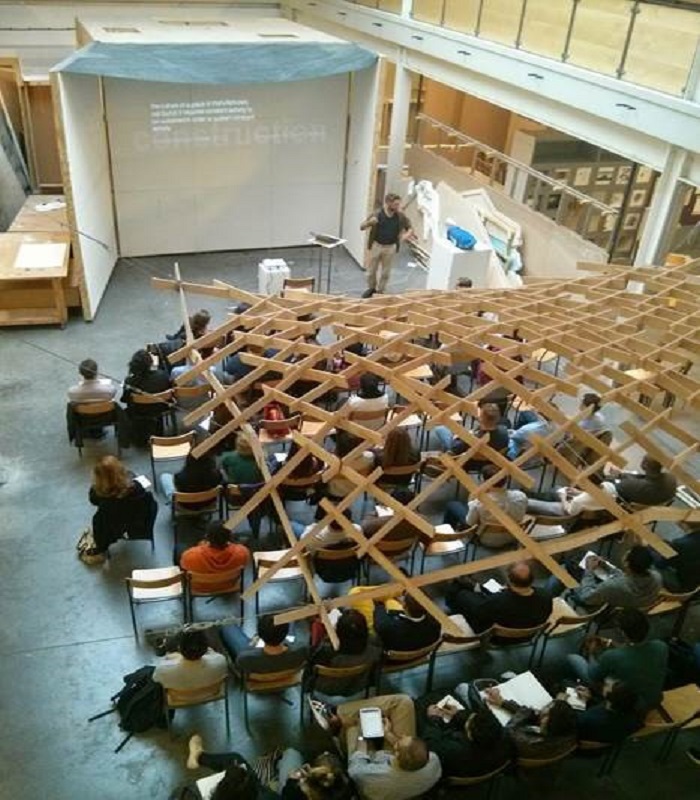Humans shoot for a better future by trying to see the bigger picture and adjusting. That’s why we analyse trends, model scenarios, and quantify risks. Recent research of this kind by the RIBA Client Liaison Group (CLG) suggests that some aspects of the profession may be off target. They think it is time to recalibrate.
The RIBA Clients into Schools of Architecture programme aims to do just that. Set up in 2016 under the auspices of CLG led by Nigel Ostime of Hawkins\Brown, it is the logical response to comments made by around two thousand client representatives during roundtable consultations and in the 2016 Working With Architects survey.
The rationale goes something like this. Schools of architecture do a brilliant job of teaching students to be strong conceptual thinkers and good designers. Clients are very satisfied with this aspect of higher education.
However, there are some concerns. Students may not develop teamwork skills, an understanding of project management and project financing, or how to empathise with a client’s priorities, competencies that are of course valued by clients. Newly qualified architects may not have had the opportunity to understand the cut-and-thrust of contemporary practice, with all its complexity, commercial constraints, and dependence on collaborative working.
Having been through the same system, these new architects’ bosses are not always aware of this culture clash. They may not correct it in their new staff, and the misunderstandings self-perpetuate, with clients faced with service that is less than smooth.

Ostime helps to deliver the programme for the Bartlett. He says, 'The education system harks back to a post-War period when architects worked for local authorities and to a fee scale. Those days are gone. With new digital technology rampant, we need to inject the commercial realpolitik of professional practice into what is taught.'
So far, six schools have taken up the opportunity, with four more starting in 2018. The CLG gives the schools a strategic framework that outlines the ultimate objective, and effects introductions to friendly developers and contractor-clients.
Thereafter it is the schools’ initiative to decide how best to integrate the idea. They target students at all stages of education, from Part 1s (University of the West of England) to Part 3s (The Bartlett; University of Westminster). Some opt to invite clients to deliver wake-up calls in the form of a lecture or seminar. Others involve the clients in studio work, getting the students to interact with them directly.

The closer students can get to a real project, the more valuable the exercise. The University of East London, for example, has been running client-focused classes for many years, but has done so under the RIBA programme for two years.
Run by Roland Karthaus of Matter Architecture, their course is aimed at Part 2s. He has persuaded seven clients to allow groups of students to investigate seven big, complex, live projects with a total development value of several billion. They hear the client’s brief. They interview the design team and contractor. They study the site. Each group has to produce a report and give a joint presentation back to the client.
The students may occasionally get lost and that, says Karthaus, is half the point. On complex projects, no single person understands the whole picture. Knowledge is distributed among the project team, which students find unfamiliar. “Often they freeze up to begin with, not knowing where to start when they don't have all the pieces. But they learn.”
Karthaus is frustrated by the culture gap that persists between design education and practice. The ceaseless questioning taught in the internationally acclaimed British system is exactly the skill that should add value to clients’ development appraisals. "Creative people have more to offer than purely physical design skills" he says "both schools and the wider industry should realise this and nurture it"
For Karthaus, the programme is a crash course in aligning architects’ objectives to clients’. 'Often this is just a matter of how architects articulate their aims. But it leads to miscommunication and, in the worst cases, mistrust. Client experience should be compulsory.' Ostime agrees: 'There are far-reaching consequences if we don’t do this. It talks about the future of the profession. We have to address it.'
If your school already addresses the issues discussed here, or you would like to get involved in the RIBA Clients into Schools of Architecture programme, contact Linda Stevens, RIBA Head of Client Services on 0207 307 3635, Linda.Stevens@riba.org









